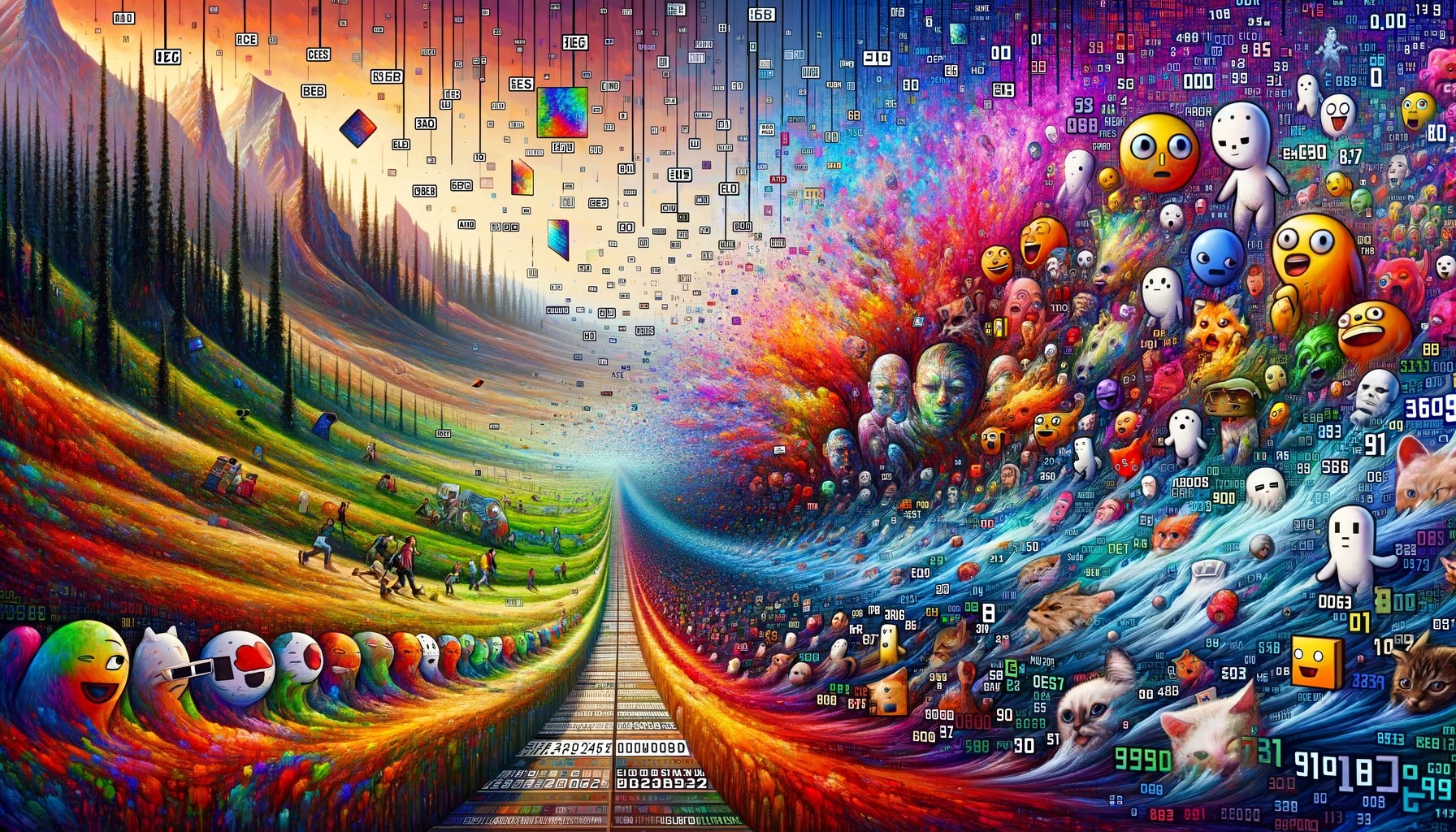
by Joche Ojeda | Jan 3, 2024 | A.I
Navigating the Limitations of Large Language Models: Understanding Outdated Information, Lack of Data Sources, and the Comparative Advantages of Retrieval-Augmented Generation (RAG)
Introduction
In the rapidly evolving field of artificial intelligence, Large Language Models (LLMs) like OpenAI’s GPT series have become central to various applications. However, despite their impressive capabilities, these models exhibit certain undesirable behaviors that can impact their effectiveness. This article delves into two significant limitations of LLMs – outdated information and the absence of data sources – and compares their functionality with Retrieval-Augmented Generation (RAG), highlighting the advantages of RAG over traditional fine-tuning approaches in LLMs.
1. Outdated Information in Large Language Models
A prominent issue with LLMs is their reliance on pre-existing datasets that may not include the most current information. Since these models are trained on data available up to a certain point in time, any developments post-training are not captured in the model’s responses. This limitation is particularly noticeable in fields with rapid advancements like technology, medicine, and current affairs.
2. Lack of Data Source Attribution
LLMs generate responses based on patterns learned from their training data, but they do not provide references or sources for the information they present. This lack of transparency can be problematic in academic, professional, and research settings where source verification is crucial. Users may find it challenging to distinguish between factual information, well-informed guesses, and outright fabrications.
Comparing LLMs with Retrieval-Augmented Generation (RAG)
Retrieval-Augmented Generation (RAG) presents a solution to some of the limitations faced by LLMs. RAG combines the generative capabilities of LLMs with the information retrieval aspect, pulling in data from external sources in real-time. This approach allows RAG to access and integrate the most recent information, overcoming the outdated information issue inherent in LLMs.
Why RAG Excels Over Fine-Tuning in LLMs
Fine-tuning involves additional training of a pre-trained model on a specific dataset to tailor it to particular needs or improve its performance in certain areas. While effective, fine-tuning does not address the core issues of outdated information and source attribution.
- Dynamic Information Update: Unlike fine-tuned LLMs, RAG can access the latest information, ensuring responses are more current and relevant.
- Source Attribution: RAG provides the ability to trace back the information to its source, enhancing credibility and reliability.
- Customizability and Flexibility: RAG can be customized to pull information from specific databases or sources, catering to niche requirements more effectively than a broadly fine-tuned LLM.
Conclusion
While Large Language Models have transformed the AI landscape, their limitations, particularly regarding outdated information and lack of data source attribution, pose challenges. Retrieval-Augmented Generation offers a promising alternative, addressing these issues by integrating real-time data retrieval with generative capabilities. As AI continues to advance, the synergy between generative models and information retrieval systems like RAG is likely to become increasingly significant, paving the way for more accurate, reliable, and transparent AI-driven solutions.

by Joche Ojeda | Jan 3, 2024 | A.I
Enhancing AI Language Models with Retrieval-Augmented Generation
Introduction
In the world of natural language processing and artificial intelligence, researchers and developers are constantly searching for ways to improve the capabilities of AI language models. One of the latest innovations in this field is Retrieval-Augmented Generation (RAG), a technique that combines the power of language generation with the ability to retrieve relevant information from a knowledge source. In this article, we will explore what RAG is, how it works, and its potential applications in various industries.
What is Retrieval-Augmented Generation?
Retrieval-Augmented Generation is a method that enhances AI language models by allowing them to access external knowledge sources to generate more accurate and contextually relevant responses. Instead of relying solely on the model’s internal knowledge, RAG enables the AI to retrieve relevant information from a database or a knowledge source, such as Wikipedia, and use that information to generate a response.
How does Retrieval-Augmented Generation work?
RAG consists of two main components: a neural retriever and a neural generator. The neural retriever is responsible for finding relevant information from the external knowledge source. It does this by searching for documents that are most similar to the input text or query. Once the relevant documents are retrieved, the neural generator processes the retrieved information and generates a response based on the context provided by the input text and the retrieved documents.
The neural retriever and the neural generator work together to create a more accurate and contextually relevant response. This combination allows the AI to produce higher-quality outputs and reduces the likelihood of generating incorrect or nonsensical information.
Potential Applications of Retrieval-Augmented Generation
Retrieval-Augmented Generation has a wide range of potential applications in various industries. Some of the most promising use cases include:
- Customer service: RAG can be used to improve the quality of customer service chatbots, allowing them to provide more accurate and relevant information to customers.
- Education: RAG can be used to create educational tools that provide students with accurate and up-to-date information on a wide range of topics.
- Healthcare: RAG can be used to develop AI systems that can assist doctors and healthcare professionals by providing accurate and relevant medical information.
- News and media: RAG can be used to create AI-powered news and media platforms that can provide users with accurate and contextually relevant information on current events and topics.
Conclusion
Retrieval-Augmented Generation is a powerful technique that has the potential to significantly enhance the capabilities of AI language models. By combining the power of language generation with the ability to retrieve relevant information from external sources, RAG can provide more accurate and contextually relevant responses. As the technology continues to develop, we can expect to see a wide range of applications for RAG in various industries.

by Joche Ojeda | Dec 31, 2023 | A.I
Unpacking Memes and AI Embeddings: An Intriguing Intersection
The Essence of Embeddings in AI
In the realm of artificial intelligence, the concept of an embedding is pivotal. It’s a method of converting complex, high-dimensional data like text, images, or sounds into a lower-dimensional space. This transformation captures the essence of the data’s most relevant features.
Imagine a vast library of books. An embedding is like a skilled librarian who can distill each book into a single, insightful summary. This process enables machines to process and understand vast swathes of data more efficiently and meaningfully.
The Meme: A Cultural Embedding
A meme is a cultural artifact, often an image with text, that encapsulates a collective experience, emotion, or idea in a highly condensed format. It’s a snippet of culture, distilled down to its most essential and relatable elements.
The Intersection: AI Embeddings and Memes
The connection between AI embeddings and memes lies in their shared essence of abstraction and distillation. Both serve as compact representations of more complex entities. An AI embedding abstracts media into a form that captures its most relevant features, just as a meme condenses an experience or idea into a simple format.
Implications and Insights
This intersection offers fascinating implications. For instance, when AI learns to understand and generate memes, it’s tapping into the cultural and emotional undercurrents that memes represent. This requires a nuanced understanding of human experiences and societal contexts – a significant challenge for AI.
Moreover, the study of memes can inform AI research, leading to more adaptable and resilient AI models.
Conclusion
In conclusion, while AI embeddings and memes operate in different domains, they share a fundamental similarity in their approach to abstraction. This intersection opens up possibilities for both AI development and our understanding of cultural phenomena.

by Joche Ojeda | Dec 18, 2023 | A.I
ONNX: Revolutionizing Interoperability in Machine Learning
The field of machine learning (ML) and artificial intelligence (AI) has witnessed a groundbreaking innovation in the form of ONNX (Open Neural Network Exchange). This open-source model format is redefining the norms of model sharing and interoperability across various ML frameworks. In this article, we explore the ONNX models, the history of the ONNX format, and the role of the ONNX Runtime in the ONNX ecosystem.
What is an ONNX Model?
ONNX stands as a universal format for representing machine learning models, bridging the gap between different ML frameworks and enabling models to be exported and utilized across diverse platforms.
The Genesis and Evolution of ONNX Format
ONNX emerged from a collaboration between Microsoft and Facebook in 2017, with the aim of overcoming the fragmentation in the ML world. Its adoption by major frameworks like TensorFlow and PyTorch was a key milestone in its evolution.
ONNX Runtime: The Engine Behind ONNX Models
ONNX Runtime is a performance-focused engine for running ONNX models, optimized for a variety of platforms and hardware configurations, from cloud-based servers to edge devices.
Where Does ONNX Runtime Run?
ONNX Runtime is cross-platform, running on operating systems such as Windows, Linux, and macOS, and is adaptable to mobile platforms and IoT devices.
ONNX Today
ONNX stands as a vital tool for developers and researchers, supported by an active open-source community and embodying the collaborative spirit of the AI and ML community.
ONNX and its runtime have reshaped the ML landscape, promoting an environment of enhanced collaboration and accessibility. As we continue to explore new frontiers in AI, ONNX’s role in simplifying model deployment and ensuring compatibility across platforms will be instrumental in advancing the field.

by Joche Ojeda | Dec 17, 2023 | A.I
In the dynamic world of artificial intelligence (AI) and machine learning (ML), diverse models such as ML.NET, BERT, and GPT each play a pivotal role in shaping the landscape of technological advancements. This article embarks on an exploratory journey to compare and contrast these three distinct AI paradigms. Our goal is to provide clarity and insight into their unique functionalities, technological underpinnings, and practical applications, catering to AI practitioners, technology enthusiasts, and the curious alike.
1. Models Created Using ML.NET:
- Purpose and Use Case: Tailored for a wide array of ML tasks, ML.NET is versatile for .NET developers for customized model creation.
- Technology: Supports a range of algorithms, from conventional ML techniques to deep learning models.
- Customization and Flexibility: Offers extensive customization in data processing and algorithm selection.
- Scope: Suited for varied ML tasks within .NET-centric environments.
2. BERT (Bidirectional Encoder Representations from Transformers):
- Purpose and Use Case: Revolutionizes language understanding, impacting search and contextual language processing.
- Technology: Employs the Transformer architecture for holistic word context understanding.
- Pre-trained Model: Extensively pre-trained, fine-tuned for specialized NLP tasks.
- Scope: Used for tasks requiring deep language comprehension and context analysis.
3. GPT (Generative Pre-trained Transformer), such as ChatGPT:
- Purpose and Use Case: Known for advanced text generation, adept at producing coherent and context-aware text.
- Technology: Relies on the Transformer architecture for subsequent word prediction in text.
- Pre-trained Model: Trained on vast text datasets, adaptable for broad and specialized tasks.
- Scope: Ideal for text generation and conversational AI, simulating human-like interactions.
Conclusion:
Each of these AI models – ML.NET, BERT, and GPT – brings unique strengths to the table. ML.NET offers machine learning solutions in .NET frameworks, BERT transforms natural language processing with deep language context understanding, and GPT models lead in text generation, creating human-like text. The choice among these models depends on specific project requirements, be it advanced language processing, custom ML solutions, or seamless text generation. Understanding these models’ distinctions and applications is crucial for innovative solutions and advancements in AI and ML.




